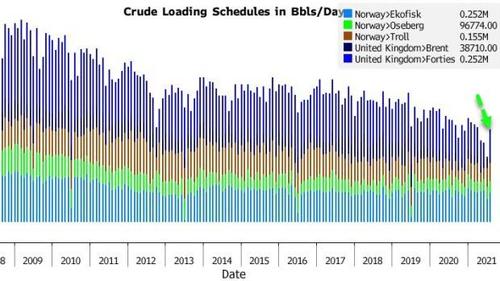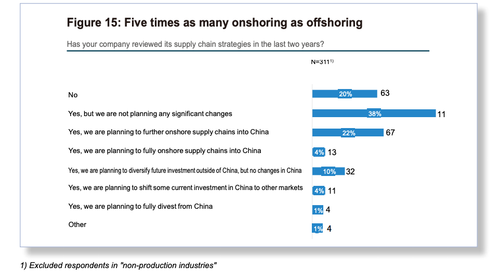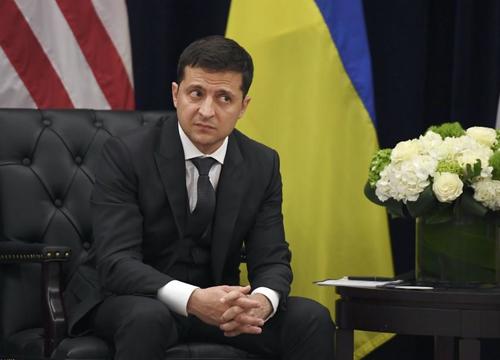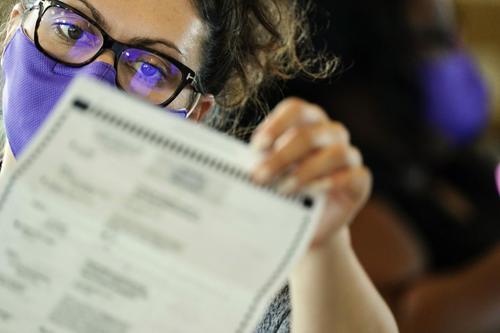Authored by Soeren Kern via The Gatestone Institute,
The Danish Parliament has passed a new law that will allow the government to deport asylum seekers to countries outside of the European Union to have their cases considered abroad. The legislation is widely seen as a first step toward moving the country’s asylum screening process beyond Danish borders.

The law, proposed by the Social Democrat-led government, is aimed at discouraging frivolous asylum applications. It has been greeted with fury by those who favor mass migration, presumably out of fear that other EU countries may now follow Denmark’s lead.
Denmark, which already has some of the most restrictive immigration policies in Europe, is at the vanguard of European efforts to preserve local traditions and values in the face of mass migration, runaway multiculturalism, and the systematic encroachment of political Islam.
An amendment to the Aliens Act, approved on June 3 by 70 votes to 24, authorizes the government to enter into agreements with non-EU countries (so-called third countries) to allow it to “transfer third-country nationals and stateless persons who apply for asylum in Denmark to the third country in question for the purpose of substantive processing of asylum applications.”
Danish Immigration Minister Mattias Tesfaye, a Social Democrat and the son of an Ethiopian immigrant, told the Financial Times that Denmark had “identified a handful of countries,” mostly in Africa, that might be open to hosting migrant reception centers.
In April, Tesfaye signed a “Memorandum of Understanding” with Rwanda regarding “cooperation on asylum and migration issues.” The document raised speculation that Denmark wants to transfer migrants to the East African country, which has a tradition of hosting refugees. The memorandum spelled out the Danish government’s long-term objective:
“Denmark is committed to finding new and sustainable solutions to the present migration and refugee challenges that affect countries of origin, transit and destination. The current asylum system is unfair and unethical by incentivizing children, women and men to embark on dangerous journeys along the migratory routes, while human traffickers earn fortunes.
“There is a need to finding new ways of addressing the migration challenges by promoting a fairer and more humane asylum system based on a comprehensive approach. This includes addressing the root causes of irregular migration, providing more and better protection of refugees in the regions of conflict and increasing assistance to host nations, countries of origin and transit — along the migratory routes — in order to improve border management, strengthen asylum systems and fight human smuggling.
“It is also the vision of the Danish Government that the processing of asylum applications should take place outside of the EU in order to break the negative incentive structure of the present asylum system.”
Advocates of mass migration have criticized Denmark’s new law. The European Commission, the EU’s powerful administrative arm, said that it had “fundamental concerns” about deporting asylum seekers to countries outside of Europe:
“External processing of asylum claims raises fundamental questions about both the access to asylum procedures and effective access to protection. It is not possible under existing EU rules or proposals under the new pact for migration and asylum.”
Others have accused Denmark of seeking to “export” the asylum process. Gillian Triggs, assistant high commissioner of UNHCR, the United Nations’ refugee agency, warned that “such practices undermine the rights of those seeking safety and protection, demonize and punish them and may put their lives at risk.”
UNHCR global spokesperson Shabia Mantoo added that the agency “remains firmly opposed to national initiatives that forcibly transfer asylum-seekers to other countries and undermine the principles of international refugee protection.”
In an interview with Euronews, Nikolas Feith Tan, a senior researcher at the Danish Institute for Human Rights, said that Denmark’s plan to house asylum seekers outside its borders represents “a fundamental shift” in how the international protection system functions:
“Up until now, refugee protection has been primarily territorial. If you reach Denmark, then Denmark is responsible for both assessing whether you are a refugee or not, and if you are a refugee, then for granting you protection. The new legislation shifts that idea of territorial asylum.”
Tan said that transferring asylum seekers abroad in principle does not violate international law, but that the government should still expect be sued in Danish courts and at the European Court of Human Rights.
Tesfaye said that “a key aim” was to reduce the number of “spontaneous” asylum seekers to Denmark:
“The current asylum system has failed. It is inefficient and unfair. Children, women and men are drowning in the Mediterranean or are abused along the migratory routes, while human traffickers earn fortunes.”
Other Measures to Curb Mass Migration
Since assuming power in June 2019, the government of Danish Prime Minister Mette Frederiksen has introduced a raft of measures aimed at curbing mass migration. The measures build on those implemented by previous governments.
June 3, 2021. The Danish Parliament approved by 78 votes to 16 a new law that authorizes the government to revoke Danish citizenship from immigrants who are members of criminal gangs. The law is aimed at tackling a surge in migration-linked violent crime. The amendment to the Citizenship Act allows for the “denial of citizenship for certain forms of serious gang crimes considered detrimental to the vital interests of the State.” The law applies only to dual nationals and not to gang members who, by losing their Danish citizenship, would become stateless. The new law, which is not retroactive, enters into force on July 1, 2021.
Minister of Justice Nick Hækkerup said:
“Gang crime in no way belongs in Denmark. When foreigners or persons to whom we in Denmark have granted Danish citizenship participate in the gangs’ ruthless crime, it is a fundamental expression of contempt for the society of which they are a part. Therefore, it is good news that Parliament has today passed the government’s bill to provide the opportunity to revoke citizenship in the event of serious gang crime to the serious detriment of the state’s vital interests. It is a goal for the government to ensure that Danes can be safe in their everyday lives. When the gangs challenge that security, it must have noticeable consequences.”
May 26, 2021. The Danish Parliament approved by 67 votes to 26 a first-ever Repatriation Law which authorizes the government to deport failed asylum seekers and other migrants illegally in the country. The law allows the government to monitor foreigners’ mobile phones in order to more easily identify and deport them.
The law was approved amid reports that migrants who had been paid between 100,000 and 225,000 Danish kroner ($16,000 and $37,000) by the Danish government to leave the country took the money but then disappeared without actually leaving. Others took the money and left the country and later returned.
Minister for Foreign Affairs and Integration Mattias Tesfaye said:
“We have too many foreigners without legal residence in Denmark who do not return home. It is unsustainable. Both for the individual and for the Danish state, which must spend money on accommodating these people…. The penalties have been increased for those with deportation orders who do not comply with their control obligations. Now we have taken the next step towards a coherent repatriation policy. It is intended to help more foreigners without legal residence to return to their home countries. I am glad that there is broad support for this in the parliament.”
May 6, 2021. The Danish government tightened citizenship rules. In future, individuals with criminal records will be excluded from obtaining Danish citizenship. Individuals found guilty of committing immigration or social security fraud must wait for six years for their citizenship application to be considered. The new rules also introduced an employment requirement. Applicants must have been in full-time employment or have been self-employed for at least three years and six months within the previous four years. Five questions about Danish values have been added to the citizenship test. Applicants will be required to correctly answer four out of the five questions. “There is great agreement among the parties to the agreement that it is crucial that an applicant has adopted Danish values,” the government said in a statement.
Minister for Foreign Affairs and Integration Mattias Tesfaye said:
“We have to draw a line in the sand. People who have been imprisoned must not have Danish citizenship.”
Spokesman for the Liberal Party, Morten Dahlin, added:
“Danish citizenship is a gift to be earned. Therefore, we must make an effort when handing out passports. Those we welcome in the Danish family must have embraced Denmark and stayed on the right side of the law. That is why we in the Liberal Party are happy that there is now a greater focus on Danish values and that there is a crackdown on foreigners who have committed crimes. These have been important demands on our part.”
Conservative Rapporteur Marcus Knuth said:
“The Conservatives have been fighting for new rules for Danish citizenship for over a year. It is especially important to us that criminal foreigners with a prison sentence can never apply for Danish citizenship, and it is important to us that there is now an employment requirement, so one must now have worked the last 3½ out of four years. We also worked on a ceiling on the number of citizenships for applicants outside the EU and the Nordic countries, but unfortunately the government would not. In return, we now have an audit provision, so the government shall call for discussions if there is a significant increase in the number of applicants.”
Liberal Alliance Rapporteur Henrik Dahl said:
“I am first and foremost happy that, as something new, we demand that new citizens have worked for some years before they can get a Danish passport. It is only reasonable that one has contributed to the Danish economy before one gets full rights in Denmark.”
March 17, 2021. The Danish government announced a package of new proposals aimed at fighting “religious and cultural parallel societies” in Denmark. A cornerstone of the plan includes capping the percentage of “non-Western” immigrants and their descendants dwelling in any given residential neighborhood. The aim is to preserve social cohesion in the country by encouraging integration and discouraging ethnic and social self-segregation.
March 9, 2021. The Danish Parliament approved a new law that bans foreign governments from financing mosques in Denmark. The measure is aimed at preventing Muslim countries, particularly Qatar, Saudi Arabia and Turkey, from promoting Islamic extremism in Danish mosques and prayer facilities.
March 9, 2021. The Danish Parliament approved by 96 votes to 0 a new law that bans religious marriages of minors and forced marriages. Islamic preachers and others who conduct such marriages now face up to two years in prison and deportation from Denmark. The same goes for parents who allow their children enter into a Sharia marriage. The penalty for detaining a person in a forced marriage was increased to four years in prison. The law also authorizes the government to withdraw the passports of children if there is reason to believe that they are being sent abroad to be married, regardless of whether the marriage is legally valid. The law bans the use of Islamic nikah marriage contracts which often make it difficult for Muslim women to seek a divorce. The new law entered into force on March 15, 2021.
February 18, 2021. The Danish government announced that it would review the residency status of 350 Syrian migrants from Syria. The move came after the Danish Refugee Board decided that the Rif Damascus region of Syria is now safe and that there is no longer a basis for granting or extending temporary residence permits.
Minister for Foreign Affairs and Integration Mattias Tesfaye said:
“Denmark has been open and honest from day one. We have made it clear to the Syrian refugees that their residence permit is temporary. It can be withdrawn if protection is no longer needed. With the Refugee Board’s decisions this week, the authorities will now review the pile of cases from the same province. This is good. We must give people protection for as long as it is needed. But when conditions in the home country improve, a former refugee should return home and re-establish a life there.”
October 3, 2020. The government proposed a new Repatriation Law to ensure that more rejected asylum seekers were sent home. At least 1,100 rejected asylum seekers in Denmark do not have the right to reside in the country, and more than 200 rejected asylum seekers have remained Denmark for a more than five years. The measures include paying failed asylum seekers 20,000 Danish kroner (€2,700; $3,600) to leave the country.
September 11, 2020. The government proposed an amendment to the Foreigners’ Citizenship Act that would deny Danish citizenship to Danish jihadists — so-called foreign fighters. Cabinet Minister Kaare Dybvad said:
“The government will go to great lengths to prevent foreign fighters who have turned their backs on Denmark from returning to Denmark. We are talking about men and women who have committed or supported outrageous crimes. Therefore, it must also be possible in the future to deprive them of their citizenship.”
September 10, 2020. The government created a new ambassadorial post and a task force to work to establish migrant reception centers in third countries outside of the European Union — in Libya, Tunisia or Morocco.
May 31, 2018. The Danish Parliament approved a ban on Islamic full-face veils in public spaces. The law, sponsored by the center-right government in power at the time, and backed by the Social Democrats and the Danish People’s Party, passed by 75 votes to 30. Anyone found wearing a burka (which covers the entire face) or a niqab (which covers the entire face except for the eyes) in public in Denmark is subject to a fine of 1,000 Danish kroner (€134; $163); repeat offenders could be fined 10,000 Danish kroner. In addition, anyone found to be requiring a person through force or threats to wear garments that cover the face could be fined or face up to two years in prison.
January 26, 2016. The Danish Parliament adopted several measures aimed at reducing the number of asylum seekers arriving in Denmark: The reintroduction of the requirement that only refugees with the highest potential for integration into Danish society be accepted; an increase in time requirement to three years for family reunifications for asylum seekers; an increase in time requirement before the awarding of permanent residency status; additional integration requirements, including the ability to prove language skills, before permanent residency can be attained; permanent and temporary residency status were made easier to lose; the introduction of fees to apply for family reunification and to convert temporary residence permit to permanent residence permit; a 10% reduction in economic aid to asylum seekers; police were given power to confiscate from asylum seekers items of value to support the cost of their stay; asylum seekers were required to live in special housing centers.
Changing Demographics
Denmark, which has a population of 5.8 million, received approximately 40,000 asylum applications during the past five years, according to data compiled by Statista. Most of the applications received by Denmark, a predominately Lutheran country, were from migrants from Muslim countries in Africa, Asia and the Middle East.
In recent years, Denmark has also permitted significant non-asylum immigration, especially from non-Western countries. Denmark is now home to sizeable immigrant communities from Syria (35,536); Turkey (33,111); Iraq (21,840); Iran (17,195); Pakistan (14,471); Afghanistan (13,864); Lebanon (12,990) and Somalia (11,282), according to Statista.
Muslims currently comprise approximately 5.5% of the Danish population, according to the Pew Research Center. Under a “zero migration scenario,” the Muslim population is projected to reach 7.6% by 2050; with a “medium migration scenario,” it is forecast to hit 11.9% by 2050; and under a “high migration scenario,” Muslims are expected to comprise 16% of the Danish population by 2050, according to Pew.
As in other European countries, mass migration has resulted in increased crime and social tension. Danish cities have been plagued by shootings, car burnings and gang violence.
During a recent EU review of the Schengen Agreement, the treaty that regulates the EU’s system of open borders, Minister for Foreign Affairs and Integration Mattias Tesfaye said:
“The possibility of reintroducing temporary border control is crucial for the security of Danes. This was shown by the refugee and migrant crisis in 2015. And the corona crisis has recently reaffirmed this. There is a need for changes to the Schengen rules so that member states have more flexibility to decide. We in Denmark know best when there is a need for control of Denmark’s borders.”
On January 22, during a parliamentary hearing on Danish immigration policy, Prime Minister Mette Frederiksen said that she was determined to reduce the number of asylum approvals:
“Our goal is zero asylum seekers. We cannot promise zero asylum seekers, but we can establish the vision for a new asylum system, and then do what we can to implement it. We must be careful that not too many people come to our country, otherwise our social cohesion cannot exist. It is already being challenged.”
In an interview with Danish broadcaster DR on June 3, MP Rasmus Stoklund said that if someone seeks refuge in Denmark in the future, he or she must expect to be deported to a third country: “Therefore, we hope that people will stop seeking asylum in Denmark.”











